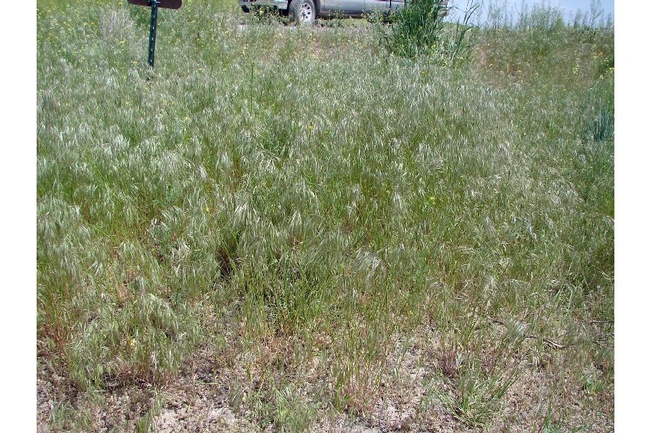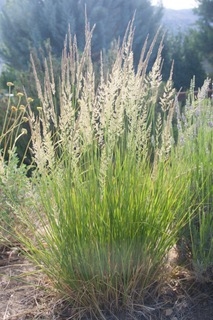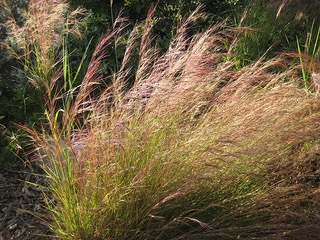- Author: Patricia Barni
Beat the Cheat
Part II: How to get rid of cheatgrass!
Part One of the cheatgrass story informed us of its invasive weed status and how it creates a fire risk around the home. But there is hope.
First, remember that any disturbance of the soil is an invitation to cheatgrass - maintaining an adequate cover of native plant species and biological soil crusts can render some communities more resistant to cheatgrass invasion.
Where soils have been disturbed, however, you must remove live plants and prevent seed production. This takes hard work and persistence and then more persistence! For small areas, hand pulling is effective if done diligently over many years. Cheatgrass is typically a winter annual grass. It grows early and rapidly (often before other annuals germinate) and is fairly easy to identify and manually pull during the cool temperatures of late winter and early spring, especially when it first appears.
For areas where mature communities persist, I have developed a 2-year eradication plan that works well. First, I lift the roots out of the ground a few inches below the soil (these fine, dry roots at the surface are another fire hazard) with a soil knife and remove as much of the plant, seeds, and roots as possible. Yes, the seeds germinate better in the light and fluffy soil left behind so I tamp down areas I have weeded to condense the soil structure. Once these nests of old grasses and seeds are gone, it is much easier to remove the new plants that might come up in year two (and three, and four...). You can also use a hula hoe but remember to rake up as much of the plants, roots, and seeds as possible.
If there is a community of cheatgrass that goes to seed before you have time to remove the plants, your neighbors will thank you if you at least remove the seeds. Using a string-trimmer when the seeds are still immature can be effective to reduce seed spread but you still need to go back and remove the plants so they do not regrow and to reduce the fire risk.
For larger infestations, chemical controls or grazing should be considered. Be careful using herbicides because those recommended for controlling cheatgrass can also harm nearby native species. UC IPM has information on controlling brome grasses including timing of herbicides, if used. Grazing by goats is another option. Grazing during the spring and fall must be used for at least two consecutive years to be effective.
The use of mechanical equipment is not recommended because it disturbs the soil and may exacerbate the problem. So plan some time for some old-fashioned weeding to get rid of this pest of a plant.
For more information:
- Author: Harold McDonald
I am a huge fan of ornamental grasses, and I've written before about their uses and a few of my perennial favorites, so I'll try not to cover the same ground in this post. It does bear repeating, though, that grasses are vastly underused in most gardens, and I think that's a shame, because they give you so much for very little investment of time and money. There is such variety in size, shape, and color that grasses can serve almost any role in the garden, and they provide year-round interest, from the brightest greens of early summer to yellows, oranges and even reds as the weather cools, colors that will brighten the winter landscape clear through until spring, when new growth starts again.
Below are a few suggestions for using grasses in your garden. Next time I'll share a few more of my favorites and some good websites for learning about and shopping for grasses.
Apply liberally No matter what their size, grasses look better when they are planted in groups of at least three, and more is generally better. Consider a mass planting, where the grasses are a beautiful stage upon which your flowers perform as the season progresses. Even when your Salvia greggii fades and your Gaillardia dies back to the ground, the subdued autumn shades and graceful forms of your grasses will provide cool-season interest.
Don't cut back until spring Winter is when the grasses really prove their worth in their landscape (as well as seeds for birds). Don't cut them back in the fall and lose out on all that beauty. Grasses are generally classified as cool-season or warm-season varieties, and cleaning them up varies a bit from species to species, but there's no reason to cut them back until the end of winter when new growth begins to appear.
There's one for every spot True grasses are in the family Poaceae, many of which are drought-tolerant, but there are plenty that like regular watering, and if that doesn't provide enough options for you, consider sedges or rushes, grass look-alikes that generally like moister, shadier conditions. And from the smallest blue fescue to our own towering Great Basin wild rye, there's a size for every purpose.
Shop around Local nurseries can provide many choices, but if, like me, you really get into grasses, you're always going to be on the lookout for something new! Love that ‘Morning Light' maiden grass (Miscanthus sinensis ‘Morning Light') you bought at the nursery? There are literally dozens of varieties and cultivars of that species, so there's probably another one you'd like even better that you may not be able to find easily.
Grow your own While nearly any nursery will have a few Pennisetum and Panicum grasses, you'll probably never find plants of some of my favorites like purple three-awn (Aristida purpurea) or silver beardgrass (Bothriochloa laguroides). Fortunately, these and many other grasses are easily grown from seed. That's generally a desirable trait, but given sufficient water, some grasses will reseed aggressively in your garden. Mexican feather grass (Nassella tenuissima) is one I don't recommend for that reason. Purple three-awn isn't quite as prolific, the new seedlings are easy to remove, and sometimes they pop up in a location you didn't previously recognize as just the perfect spot.






